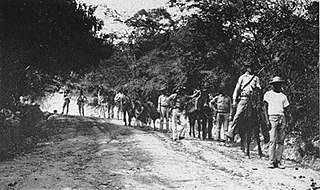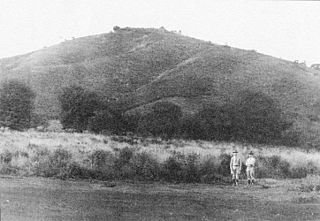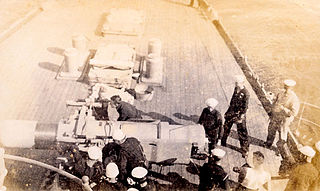
The recorded history of the Dominican Republic began in 1492 when Christopher Columbus, working for the Crown of Castile, arrived at a large island in the western Atlantic Ocean, later known as the Caribbean. The native Taíno people, an Arawakan people, had inhabited the island during the pre-Columbian era, dividing it into five chiefdoms. They referred to the eastern part of the island as Quisqueya, meaning 'mother of all lands.' Columbus claimed the island for Castile, naming it La Isla Española, which was later Latinized to Hispaniola.

The Second Battle of Fort Fisher was a successful assault by the Union Army, Navy and Marine Corps against Fort Fisher, south of Wilmington, North Carolina, near the end of the American Civil War in January 1865. Sometimes referred to as the "Gibraltar of the South" and the last major coastal stronghold of the Confederacy, Fort Fisher had tremendous strategic value during the war, providing a port for blockade runners supplying the Army of Northern Virginia.

The Asiatic Squadron was a squadron of United States Navy warships stationed in East Asia during the latter half of the 19th century. It was created in 1868 when the East India Squadron was disbanded. Vessels of the squadron were primarily involved in matters relating to American commerce with China and Japan, though it participated in several conflicts over 34 years of service until becoming the Asiatic Fleet in 1902.

The Military Government of Santo Domingo was a provisional military government established during the American occupation of the Dominican Republic that lasted from May 13, 1916 to September 18, 1924. The United States aimed to force the Dominicans to repay their large debts to European creditors, whose governments threatened military intervention. On May 13, 1916, Rear Admiral William B. Caperton forced the Dominican Republic's Secretary of War Desiderio Arias, who had seized power from President Juan Isidro Jimenes Pereyra, to leave Santo Domingo by threatening the city with naval bombardment. The Marines landed three days later and established effective control of the country within two months. Three major roads were built, largely for military purposes, connecting for the first time the capital with Santiago in the Cibao, Azua in the west, and San Pedro de Macorís in the east; the system of forced labor used by the Americans in Haiti was absent in the Dominican Republic.

The Banana Wars were a series of conflicts that consisted of military occupation, police action, and intervention by the United States in Central America and the Caribbean between the end of the Spanish–American War in 1898 and the inception of the Good Neighbor Policy in 1934. The military interventions were primarily carried out by the United States Marine Corps, which also developed a manual, the Small Wars Manual (1921) based on their experiences. On occasion, the United States Navy provided gunfire support and the United States Army also deployed troops.

The Dominican Restoration War or the Dominican War of Restoration was a guerrilla war between 1863 and 1865 in the Dominican Republic between nationalists and Spain, the latter of which had recolonized the country 17 years after its independence. The war resulted in the restoration of Dominican sovereignty, the withdrawal of Spanish forces, the separation of the Captaincy General of Santo Domingo from Spain, and the establishment of a second republic in the Dominican Republic.

The Battle of Fort Dipitié was fought on 24–25 October 1915 as part of the First Caco War during United States occupation of Haiti. U.S. Marines and rebel Haitians, known as Cacos, fought at the Grande Rivière du Nord which resulted in the destruction of Fort Dipitié, an outpost of Fort Capois.

The Battle of Fort Rivière was the decisive battle of the First Caco War during United States occupation of Haiti in 1915. A combined force of U.S. Marines and sailors defeated Cacos rebels at Fort Rivière, ending the First Caco War.

The Battle of Agua Carta, or the Battle of Lindo Lugar, was an engagement between the National Guard of Nicaragua and the rebels of Augusto César Sandino in 1932. It was fought near Mount Kilambe at the Agua Carta, a river in Sandino territory, as part of the American occupation of Nicaragua and a long lasting civil war.

The Battle of Coyotepe Hill was a significant engagement during the United States occupation of Nicaragua from August through November 1912 during the insurrection staged by Minister of War General Luis Mena against the government of President Adolfo Díaz.

The Santo Domingo Affair, or the Santo Domingo Crisis, refers to an incident from 1 February 1904 to 11 February 1904 involving the United States and Dominican militia forces in the Dominican Republic. After the death of a seaman from the USS Yankee on February 1, the U.S. military launched a punitive expedition which routed the Dominican forces.

The Battle of Ocotal occurred in July 1927, during the American occupation of Nicaragua. A large force of rebels loyal to Augusto César Sandino attacked the garrison of Ocotal, which was held by a small group of US Marines and Nicaraguan National Guards. Ultimately the rebels were defeated with heavy losses, while the Americans and their Nicaraguan allies suffered very light casualties.
The Battle of La Flor was fought in May 1928 between the United States Marines, their Nicaraguan National Guardsmen allies, and a force of Sandinista rebels. It occurred at a hill north of the La Flor coffee plantation and ended with a rebel victory when the Americans and Nicaraguan National Guard troops were forced to withdraw.

The Second Battle of Las Cruces, or the New Year's Day Battle, was a major engagement during the American occupation of Nicaragua. It was fought on 1 January 1928, during an expedition to destroy a Sandinista fortress. A column of United States Marines and Nicaraguan National Guardsmen were attacked by a superior force of rebels entrenched on Las Cruises Hill and, after a long battle, the Americans and Nicaraguans routed the Sandinistas and captured their positions.
The Nicaraguan Civil War of 1926–1927, or the Constitutionalist War, broke out after a coup d'état by Emiliano Chamorro, a member of the Conservative Party, removed Nicaragua's democratically elected government, resulting in a rebellion by members of the Liberal Party. The conflict came to an end after a military and diplomatic intervention by the United States resulted in the Pact of Espino Negro, which began the Peace of Tipitapa. Although the civil war came to an end, one Liberal general, Augusto César Sandino, refused to lay down his arms and waged the Sandino Rebellion against the Nicaraguan government and the US Marine Corps until 1933.

The Battle of San Francisco de Macoris took place on 29 November 1916 during the early stages of the United States occupation of the Dominican Republic. Dominican forces in San Francisco de Macoris had refused to lay down their arms and had taken control of the local fortress. This was in direct violation of the terms imposed by the military government installed by the United States. A small squad of Marines that were close by were able to make their way inside the fortress and surprise the defenders, securing it before any organized resistance could take place.
The Battle of Santa Clara took place on 27 July 1927, during the American occupation of Nicaragua of 1926–1933. After being ambushed by Sandinista forces at the Battle of San Fernando, Major Oliver Floyd's expedition of American Marines and Nicaraguan Provisional Guardsmen continued its advance into enemy-held territory in northern Nicaragua.
The Battle of Port-au-Prince, or "la débâcle", took place on January 15, 1920 when Haitian rebels, known as Cacos, attacked the capital of Haiti during the Second Caco War and the American occupation of Haiti.
The Battle of Masaya took place on 19 September 1912, during the American occupation of Nicaragua of 1912–1925 and the Nicaraguan civil war of 1912.
The Battle of Sapotillal, or the Battle of Zapotillal or Zapotillo Ridge, took place on the 9 October 1927 during the American occupation of Nicaragua of 1926–1933 and the Sandino Rebellion. The battle was an unsuccessful attempt by American and Nicaraguan government forces to rescue two downed American airmen.













